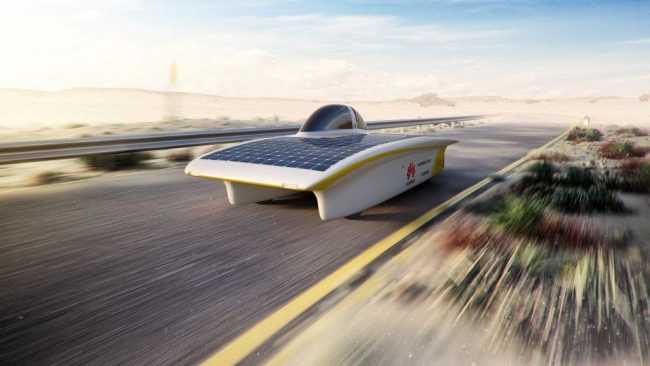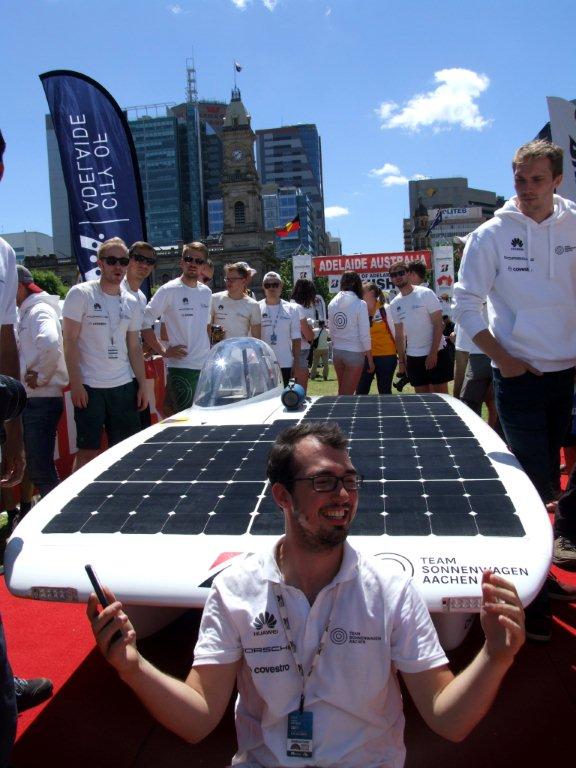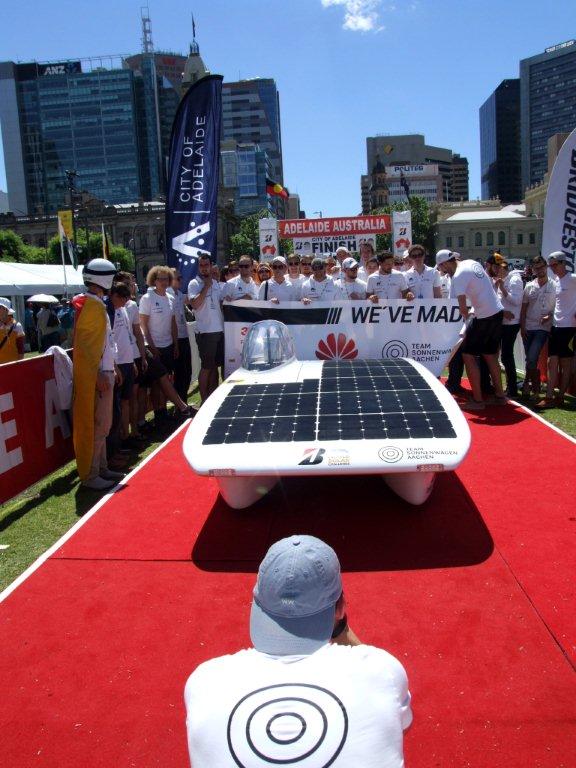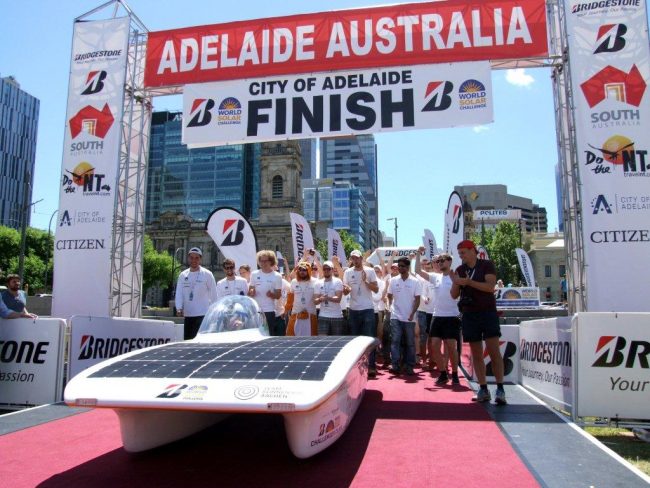Team Sonnenwagen built their solar car from scratch and only in the final months leading up to the race completed the critical power plant, a 1.4kW gearless, wheel-hub electric motor, the product of designers Marc Locke and electrical engineer Enno Dulberg.
Weight was an obvious priority, the motor weighs11kg while the battery that stores the electricity to power it weighs 20kg.
The motor is 98 per cent efficient in turning solar-generated electricity into traction. With the battery fully charged, Sonnenwagen has a range of 300km, a tenth of the distance from Darwin to Adelaide.
As it took shape, Sonnenwagen became a thing of sleek beauty, more than fitting to wear the badge of Porsche.
At 4.3m long, weighing 216kg, with a 260-cell solar panel covering 4 square metres providing a peak output of 920 watts, Sonnenwagen has a maximum speed of 140km/h, an average speed of 70km/h and consumes 1.8 kWh/100km.

Pre trial preparation – driver Marc Locke – Sonnenwagen time trial – Hidden Valley Darwin (c) Vincent Ross
Major international companies saw the value of the Sonnenwagen project, convinced by the enthusiasm of inspired young engineering minds.
The team managed to recruit 40 corporate sponsors, including German industrial leaders, international polymer and polycarbonate manufacturer Covestro and iconic motor vehicle manufacturer Porsche, which both came on board as Gold Sponsors, along with vehicle paint surface specialist PPG and Chinese telecommunications giant Huawei.
Here again, there was something that you couldn’t see which would help make the difference for the Sonnenwagen team.
Covestro would use Sonnenwagen as a “mobile laboratory”, protectively coating the shell of the solar vehicle with the aid of a new polyurethane curing agent, Desmodur, 70 per cent of which is made from biomass material – corn starch, derived from maize.
Covestro is no stranger to backing technological adventurers. In 2016 it supported the Solar Impulse on its 40,000km flight around the world without burning a drop of fossil fuel.
Solar Impulse, powered by 17,000 solar cells on a thin wingspan equivalent to that of a jumbo jet, was the brainchild of Swiss adventurers Bertrand Piccard and Andre Borschberg. A spectacular demonstration of permaculture thinking and clean technologies, the high-altitude flight required special insulation, developed by Covestro.
A spin-off from German industrial giant Bayer, Covestro focuses on developing polymers and polycarbonates and new technologies that reduce the use of fossil fuels.
It is involved in the development of polycarbonates in the production of wind turbine blades in China and is using carbon dioxide instead of oil as a catalyst (polylol) in the production of polyurethane foam, used in making mattresses, at its factory in Dormagen, Germany. Covestro says up to 25 per cent of oil currently used in the process can be replaced with carbon dioxide.
The company is also supporting the United Nations Environment program, Young Champions of the Earth, providing $15,000 seed money to six young people aged between 18 and 30, to support projects of innovation to improve the environment.
Huawei provided six-figure financial support and made available communications equipment, which kept the support team and its mobile monitoring system in constant contact with Sonnenwagen on the 3,022km journey, travelling front and rear in vehicles provided by Porsche.
Porsche gave the Sonnenwagen team access to its Weissach Development Centre, its Motorsport Centre Flacht to research aerodynamics, electrical circuitry, air freight logistics and team management, and took them to the FIA World Championship Spa in Belgium to study weather monitoring and racing strategy.
“Just like us, the Aachen students will be pushed to the absolute limit… The key issues surrounding lightweight construction, cooling, efficiency, powerful electric drive and aerodynamics correspond with the requirements of our Le Mans victor, the 919 Hybrid,” said Porsche LMP Team Principal, Andreas Seidl.
Throwing his support behind the sponsorship, Andreas Haffner from Porsche AG Board of Management said: “We want to play an active role in shaping the future of the sports car. To do so we need exactly this kind of young people, full of courage and pioneering spirit, who are willing to break the mould.”
Of the 38 teams that fronted the starting line in Darwin for the 30th Anniversary World Solar Challenge, including 13 in the rechargeable Cruiser Class and 2 in the non-competitive Adventure Class, due to technical problems or failure to make check points, 21 entries had been downgraded from the competitive Challenger Class to Adventure Class by the time they reached the finish line in Adelaide, with Sonnenwagen coming in ninth out of a field of 23 vehicles.
“We had a lot of trouble with the weather from Day 2 to Day 4, we had cloud cover and some quite heavy rain,” said Niklas Kaltz.
“We had a storm one morning at 4am and had to pack up camp. That was quite a low for us but we pushed through. The desert was more friendly than we thought it would be, but some animals were not so friendly.
“The car ran very smoothly. We didn’t encounter any major technical issues. The team built a very safe, robust car.”
On Day 5, with nine tenths of their journey behind them, Team Sonnenwagen missed the check point at Coober Pedy, 194km north of Adelaide, by ten minutes.
“That placed us in the non-competitive Adventurer Class, but we still finished,” said Niklas.
“I think the journey changed our lives, it built character. Everybody really developed. It’s definitely made us better engineers,” he said.
Aachen University’s Sonnenwagen will compete in the next World Solar Challenge in 2019, said Niklas, with a new team of bright young engineers.
“We already have many students lined up who want to follow us on this journey.”
Continued from Following the Sun – Part 1
Photo Credits
Photos by Sonnenwagen Aachen and Vincent Ross – as per photo captions







[…] Continues in Following the Sun – Part 2 […]